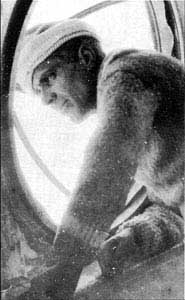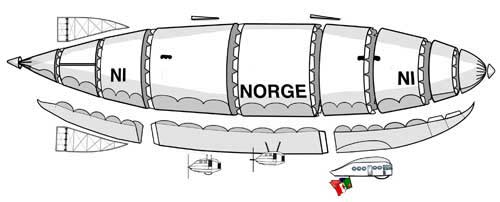



Norge Polar Explorer Airship - $$9.95
The Norge was a semi-rigid Italian-built airship that carried out what many consider the first verified overflight of the North Pole on May 12, 1926. It was also the first aircraft to fly over the polar ice cap between Europe and America. The expedition was the brainchild of polar explorer and expedition leader Roald Amundsen. Includes a step by step You Tube tutorial.
Norge N1 Polar Explorer Airship
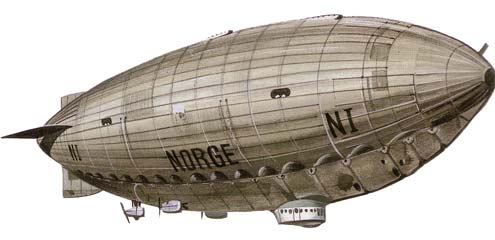
The two most famous semi-rigid airships in history were the Norge and the Italia, both constructed by the Italian government and very similar.
Even with the advent of more controllable airships, Arctic exploration held terrible traps for those who tried to fly over the frozen wastes. In 1926 the N1, an Italian semi rigid airship with a central keel and a flexible envelope, was chartered by the Norwegian explorer Roald Amundsen and his financial backer, the American James W. Ellsworth, for a flight to the North Pole.
The ship was renamed Norge (Norway) for the trip, and carried a skeleton crew of six Italians, including the commander, Colonel Umberto Nobile. They set off on this great adventure on 10 April, when the Norge left Italy.
On the 7th of May the dirigible moored in King's Bay (Spitzbergen) to make its final preparations and, four days later at 10 a.m., the airship took off. The first part of the flight went well but the later stages were another story. The airship Norge made it over the North Pole on 12 May 1926. Battered by the fog and bad weather, the Norge only managed to land on 14 May, in Alaska.
Then there was the disastrous follow-up flight of the 'Italia'..
As a result of intense personal rivalry following the success of the Norge expedition, General Umberto Nobile arranged as all-Italian flight over the Pole in an improved airship, the 'Italia'. Neither the ship nor the crew were equal to the task and a terrible series of disasters occurred. Nobile returned to Italy in disgrace.
The larger version of our Norge measures some 29 inches from stem to stern and takes about three evenings put together. There's lots of interesting stuff packed onto the pages about airships in general. There's a free downloadable contact sheet of all the page thumbnails along with other Norge related models you might want to check out are:
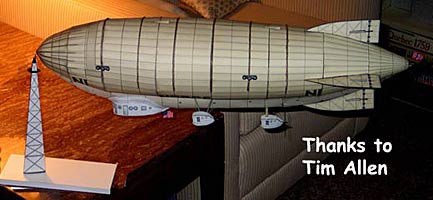 Thank You! The Norge is great! Here are some pictures of my own Norge. As you can see, I managed to get it to "float" at it's mooring mast. That's not a photoshop re-touched picture; its a block of wood with a cut down coat hanger stuck into it. I then built the mooring mast, made a hole at the top, slid the mast over the hanger, bent the hanger, then slid the Norge on through a small hole in the nose. You asked to see some pictures of it flying...this is as close as I could get . :-) Keep up the great work... FG stuff just keeps getting better! talk to ya later, Tim Allen |
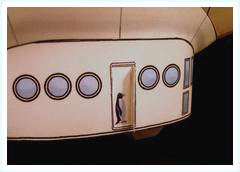 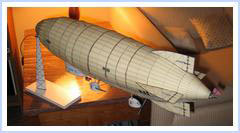 Look where Tim placed one of the penguins.. |
The
Norge is just beautiful. If I didn't have the Y1B-17's to
build I would of had one put together by
now. I keep getting it out to look at it. J Dell
Just downloaded a copy. Outstanding. Looks amazingly simple to put together considering the complexity of the subject. GReat! sb
The Norge is absolutely gorgeous! I really like all the little facts you've splayed all over the instructions also. T
Thanks!! I'll have to offer my accolades as well. Simply outstanding! I gotta figure out how to blow it up 247% to make it WSAM now. I NEED this hanging in my office! (One more project added to the list.) BB
Building the Norge was an adventure! It looks great (from a distance of about six feet). Get any closer and it looks like the Norge upon completion of its trip to the North Pole. Its sheer size is impressive. I strongly recommend it, especially as a two-person project, like father & son, for example. It helps to have someone to hold it while you glue things to it.
My only mistake was not printing it on heavy card stock. I used 67lb instead of 110lb. The main problem was that the keel didn't fit the curvature of the envelope very well and I have to do some surgery on it. Next, you should produce the Graf Zeppelin. Or maybe the Hindenberg (anybody got a match?). Bill Pace Dayton OH
Dear Fiddler's Green Staff Members: I just got from PMI Paper Models International your NORGE and your Santos-Dumont Airship No. 6 and they are very beautiful kits indeed. I will start work on the Norge shortly and it will be a lot of fun. I hope you would consider doing other airships in the same scale and I can share information with you. Alain
.jpg) Hello
Chip,
Hello
Chip,
Greetings from the Zeppelin/DeBeers survey team in Jwaneng,
Botswana. FG helps greatly to keep us sane down
here as there is little else for us to do. As you can see,
I have already completed the Piasecki helicopter and the
Split Rock lighthouse.
My next project will be the Norge and I have a quick question
about the keel before I get too far along. When attaching
the keel to the "airbag" (BTW: the term we use
is "envelope" or "hull")should the keel
be fully assembled first, with all three of the keel sections
glued together, or should I attach them individually, gluing
the keel sections together during or after attachment to
the hull?
Many thanks for the great work that you are doing for all
of us who are posted way out here in the middle of nowhere,
as well as for any advice you give me on my keel question.
All the Best, Scott Danneker Pilot, Zeppelin/DeBeers
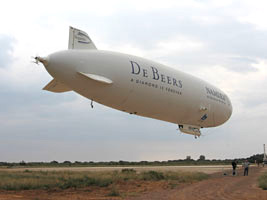
Scott
I always build it by assembling the keel first..We build
new release about a dozen times or until it's as right as
possible. There are so many variables that the chances of
the envelope and keel exactly lining up is slim at best...but
it'll be close. That's why the alignment 'scallops' on the
envelope are not bold and strong. Isn't the internet great!!!!!!
It's like you're in the next room. Thanks for the email
Scott and PLEASE send along any critiques so we can make
it even better, OK? YMP Chip (see below)
just bought your airship Norge. Thank you for a very rapid response! And it looks all very nice. However:
I don't mind the penguins included. Or the crew. But at an average height of 34 mm, your page 1 "scale= 154:1" would imply that Roald Admundsen and coworkers were plus 5 meters tall? Well, with cabin doors at 22 mm corresponding to 3.38 m height, they might still squeeze in -.
But I don't believe Norge had propellers at 9 m size either. In conclusion, your "sheet 9" with canopy is most probably at a scale of 100:1 or less, maybe 80:1 or so! Or?
However, your claim that the final model should have a length of "some 29 inches", corresponds reasonably well with a scale around 150:1 and a true full length of 106 m. Or?
Looking at the pictures of the completed model at your website, in should be evident to anyone that the cabin is severely oversized compared to the rest of the airship. What about the engines?
Please help me out here! Best regards, Kjetill Østgaard
I made an inquiry on the colors of the Norge's envelope from
the NASM (National Air and Space Museum) and when I get an
answer from them concerning the ships silver? color or in
natural linen, I will share the results with you.
I sincerely hope that you are right concerning the Norge's
envelope color. Again, thank you for your wonderful model
of the Norge, and thank you for your wonderful website. Best
regards, Alain
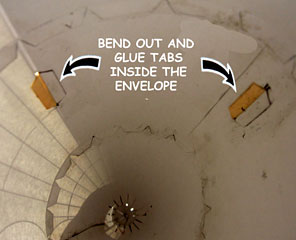 |
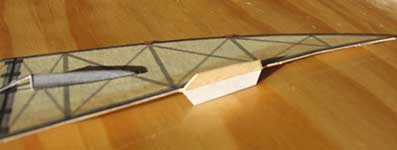 Hi again from the Dark Continent! My Norge is finished and I must say that the final product provided me with the most satisfying result I have ever achieved from the several paper models that I have built over the years. |
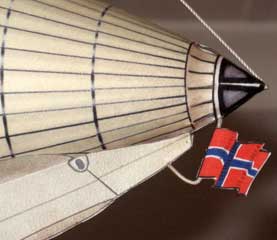 |
However, the endeavor did not come without its hiccups and I think that relating some of the problems that I encountered during construction (primarily of my own making) will serve to assist others who may wish to follow. So here we go (see below). |
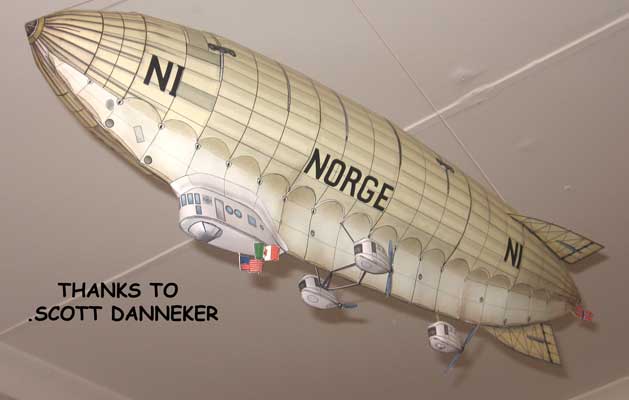
Hull (“airbag”) Construction:
So, after this digression, I recommend that you “take advantage of the keel.” By this I mean push any mistakes made in diameter matching down south to where they cannot be seen; namely under the keel. Apologies to the good folks at FG for my impudence, but here I differ with their advice to glue the top tabs first and the bottom tabs next. By doing this, any slight mistakes you may have made in matching the hull section diameters will show up on the part of the hull that can be seen. To avoid this, I recommend the following: glue the top tabs (let’s call this 12 o’clock) as instructed, and then glue the 3 and 9 o’clock positions (one at a time) after making sure that the hull sections butt together nicely between those positions and the top. After this, work upwards towards toward the top, ensuring that there are no bulges or dimples in the process. Once the upper half of
the hull is aligned and the glue is fully set, work downward
towards the 6 o’clock position (“south”) again
ensuring proper alignment. If you find (as I did on occasion)
that the hull cylinder diameters don’t exactly match,
make a small cut along the bottom seam and re-glue. When finished,
the resulting bulge will be covered by the keel and the visible
sections of the hull will remain nice and “sleek.”
By taking advantage of the keel, precise hull construction of
the already inherently forgiving FG Norge becomes a piece of
cake!
|
|
There are 16 glorious sheets to the large version of the Norge (four shown above). You can print in black and white if you use ivory (lt yellow) cardstock.. Use #110 stock if your printer can handle it. Just ONE sheet is in full color. One sheet is best printed on clear plastic. There's a mooring tower that Matt Sparks so kindly contributed.
The Norge drops flags as it crosses the North Pole, in this (right) advertisement for a French producer of canned meat extract. The Fiddlers Green Norge is really quite easy to build. We've even given much thought and effort into keeping the cutting-out as quick and easy as possible.
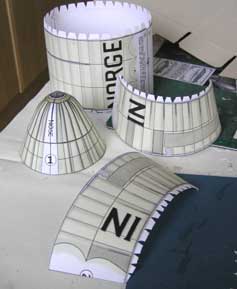 |
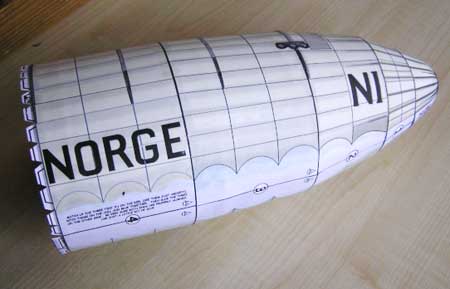 |
| Norge Airship Model Build In Progress Jan Kytop. | |
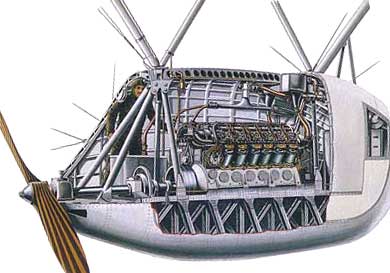 Cutaway of an airship engine |
Norge Airship - Polar Explorer
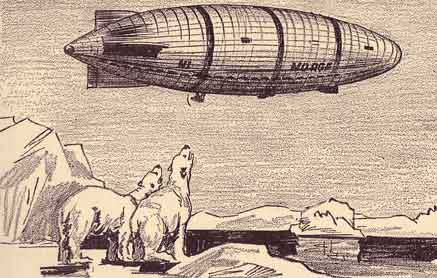 The 1920s Norwegian explorer Roald Amundsen (1872-1928) - the
man who had beaten Captain Scott to the South Pole in 1911 - launched
a bid to become first to fly over the North Pole. After Amundsen's
first attempt failed in 1925, he found himself in a race with
US Navy Commander Richard E. Byrd (1888-1957), who had the same
ambition.
The 1920s Norwegian explorer Roald Amundsen (1872-1928) - the
man who had beaten Captain Scott to the South Pole in 1911 - launched
a bid to become first to fly over the North Pole. After Amundsen's
first attempt failed in 1925, he found himself in a race with
US Navy Commander Richard E. Byrd (1888-1957), who had the same
ambition.
Byrd signed up two pilots (a mail pilot called Charles Lindbergh applied for the job but was too late) and took a prototype trimotor Fokker to King's Bay, Spitzbergen, Norway. In May 1926, Amundsen also arrived, this time in an Italian airship, the Norge, piloted by Umberto Nobile.
First to the pole
After unsuccessful earlier attempts to fly to the North Pole, Amundsen and his American friend Lincoln Ellsworth, with two Norwegian pilots and two mechanics, took off from Kings Bay, Spitzbergen, in the late afternoon of 21 May, 1925 in two twin-engine, open-cockpit Dornier Wal flying-boats numbered N.24 and N.25. All went well for seven hours, until one of N.25's engines failed.
This aircraft made a safe landing, but N. 24 was holed by ice while making its own landing three miles away. On checking their positions, the two explorers discovered that they had come tantalizingly close to the required latitude 87° 44' N but that drift, which they were not equipped to measure accurately, had carried them I° 20' W of their goal, leaving them still 136 miles from the Pole.
They survived an incredible 16 days of hardship on the ice before, with its faulty engine repaired and all six men crowded on board, N.25 was able to lumber off the ice and fly them back to Spitzbergen.
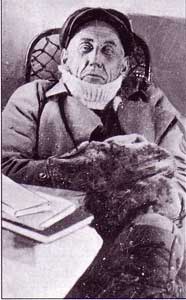 Photo of happy Roald Amundsen |
Umberto Nobile |
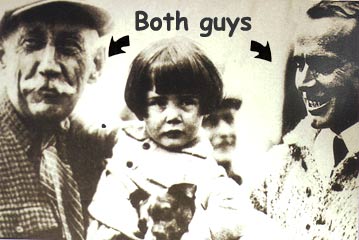 |
|
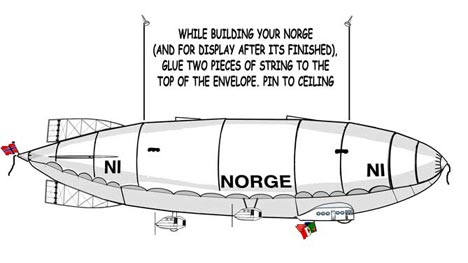 Almost immediately, Amundsen and Ellsworth began
to plan another attempt, this time by airship, and approached
the Italian government to request use of the 670,980 cubic foot
semi-rigid N. 1 built by Colonel Umberto Nobile.
Almost immediately, Amundsen and Ellsworth began
to plan another attempt, this time by airship, and approached
the Italian government to request use of the 670,980 cubic foot
semi-rigid N. 1 built by Colonel Umberto Nobile.
This arrangement was approved by Mussolini on two conditions: that Nobile was appointed as airship commander, with five other Italians forming part of the crew, and that Italy would repurchase the N. l if it survived the expedition in good condition. After being stripped. re-equipped and renamed Norge, the N. l arrived in Spitzbergen on 7 May 1926, having had a four-week, 5,000-mile roundabout trip.
By that time, however, there was a serious rival already on the scene in the form of Lieutenant Commander Richard Evelyn Byrd of the US Navy, who was ready with his own attempt to reach the North Pole by airplane.
Amundsen's efforts, although he was denied his cherished
'first' for a second time, did not go un rewarded. The Norge took
off two days after Josephine Ford, remaining airborne (in a rather
more eventful flight) for nearly three and a half days during
which it passed over the Pole, continuing its journey to land
at Teller, Alaska, on 14 May. Amundsen thereby achieved the first
flight to traverse the Arctic completely. 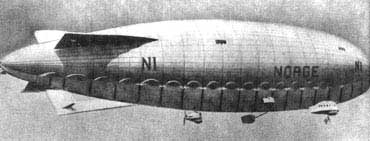
He and his helmsman, Oskar Wisting, also gained the well-deserved distinction of becoming the first men in history to visit both Poles. Despite some envelope damage, caused by lumps of ice flying off the propellers, the airship was largely unscathed, enabling Amundsen to claim the $46,000 'repurchase' price for returning it safely to Italian ownership.
Like Byrd's flight, that of the Norge was a remarkable feat of navigation and airmanship, but its achievement was sadly marred by some over-publicized personal differences between Amundsen and Nobile after the event. These were never settled directly. But when Nobile in his new airship Italia crashed in the Arctic two years later, Amundsen and his Norwegian pilot of 1925, Lief Dietrichson, volunteered to join the seven-nation aerial search for them.
Tragically, although Nobile and seven of the Italia's 15-man crew were rescued, the only casualties among the would-be rescuers were Amundsen, Dietrichson and their four-man crew, whose aircraft crashed en route to Spitzbergen without even reaching the search area.

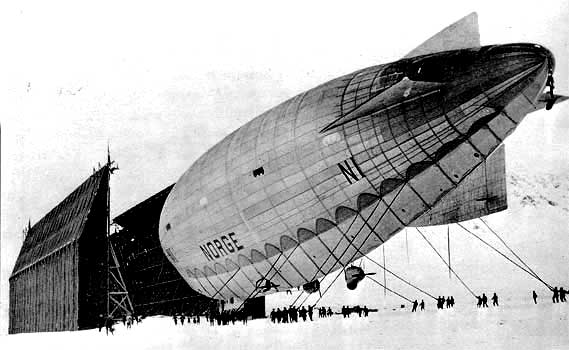
Another Version...
By 7 May 1926, the airship had arrived at King's Bay in Spitzbergen, ready for a planned flight across the North Pole and southwards to Nome in Alaska. Four days later, it took off and reached the Pole in 17 hours, where the crew dropped Norwegian, Italian, and American flags onto the ice. The Norge then set the course for Alaska, but ran into dense fog, while ice condensed on the structure and the envelope, and the compasses were useless because of the closeness of the magnetic Pole.
In the end, the airship made it as far as a frozen lake 56 miles north of Nome, when Amundsen insisted on a landing. They managed a smooth touchdown, and pulled the gas-release cords to deflate the airship. They had very nearly reached their destination, after a flight of 3,400 miles, but the ensuing publicity caused sharp differences of opinion between Nobile and Amundsen, who each accused the other of incompetence.
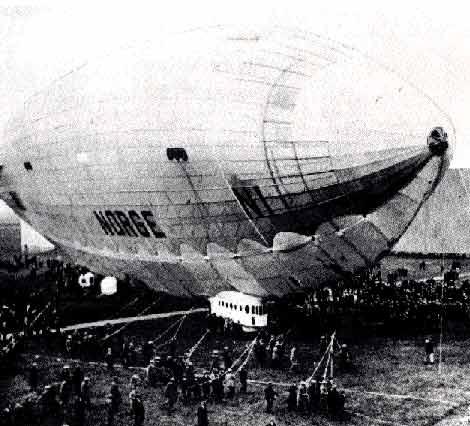
This dispute convinced Nobile, now promoted to general, that he should prove his point by mounting a second expedition, under entirely Italian control. He adapted a new airship, of similar size to the Norge, which was to be named Italia, and planned a series of flights from Spitzbergen to the nearby Arctic coasts and on to the Pole. The expedition landed at their King's Bay base in May of 1928, two years after the Norge's flight.
Back to the Pole The Polar flight began at on 23 May, with the Italia flying northwest to pick up the Greenland coast, cruising on two of its three engines. Helped by a brisk tailwind, it reached the Pole at 12.20 am on 24 May. Once again, flags were dropped, including the standard of the City of Milan, which had helped back the expedition, a small medallion of the Virgin Mary, and a wooden cross given to Nobile by Pope Pius XI before the expedition left Italy for the Arctic.
After an hour over the Pole the weather began to worsen, so it was decided to turn back for King's Bay. Unfortunately, the tailwind was now against them, and ice was building up on the outer skin of the airship. With the airship becoming heavier, and the wind becoming ferocious, the signs were set for disaster. At 6 am on 25 May, and again at 10, distress signals were received from the Italia, followed by total silence.
Deadly rivalry:
In spite of their successful collaboration in the flight of the
Norge over the Arctic, Colonel (later General) Umberto Nobile
and the Norwegian explorer Roald Amundsen became enemies. Nobile
complained that Amundsen had contributed nothing to the trip,
and its success had been due entirely to his airship, and his
skill at commanding it. Amundsen countered by accusing Nobile
of inexperience with Arctic conditions, and with dangerous incompetence.
Nevertheless, when Nobile's Italia crashed on the ice, Amundsen was quick to offer his help. With his fellow Norwegian Lief Dietrichsen, he joined the three-man crew of a French Latdcobre flying boat. They took off to join the air search, and were never seen again. A man who had survived years of exploration in the toughest of Polar conditions had died in going to the rescue of his sharpest critic and deadliest rival.
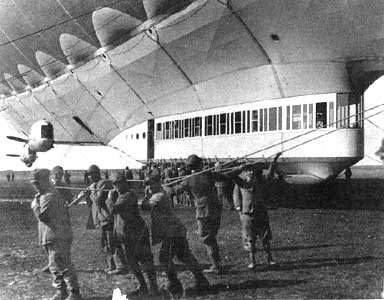 This is the Italia gondola |
Half an hour after the sending of the second signal, the sinking airship struck the ice so violently that one of the engine cars and the main control gondola were torn off the structure. Freed of their weight, the airship, with seven crew members still aboard, rose into the storm and was never seen again. One mechanic died in the crash, but the other 10 survivors, including Nobile with a broken arm and leg, were forced to shelter in a tent, where they sent out desperate calls for help on an emergency radio transmitter salvaged from the wreck.
By the time rescue reached the camp on 17 June, in the shape of a Swedish biplane fitted with skis, three of the party-two Italian naval officers and an injured scientist named Malmgren-had set off across the ice to find their own salvation. The airplane could carry only one person in addition to its two-man crew, so General Nobile was taken back to their base, to help coordinate the air search being mounted by five different nations.
The Swedish pilot returned to the camp without his observer, to pick up more survivors, but crashed on landing, damaging the skis so badly that a take-off was impossible. This added another to the five explorers still awaiting rescue, though two weeks after the original landing the pilot was picked up when his observer managed to reach the camp in another plane on 6 July.
Russia to the rescue:
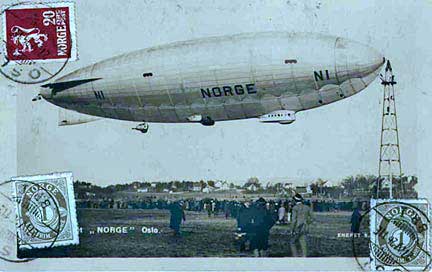 It was now six weeks since the original crash and more than a
month since three of the crew had set out across the ice to find
help. As the weather worsened, making it impossible for other
planes to locate or approach the camp, the situation looked increasingly
bleak. Yet, unknown to the small group waiting patiently on the
ice, the Russian icebreakers Krassin and Malygin were steaming
through the fog toward them.
It was now six weeks since the original crash and more than a
month since three of the crew had set out across the ice to find
help. As the weather worsened, making it impossible for other
planes to locate or approach the camp, the situation looked increasingly
bleak. Yet, unknown to the small group waiting patiently on the
ice, the Russian icebreakers Krassin and Malygin were steaming
through the fog toward them.
During one break in the clouds, Krassin had been able to launch its spotter plane, which had detected the two naval officers walking across the ice, and the ship had picked them up. Dr Malmgren had had to be left behind on their journey, close to death, and his body was never found. The very next day, Krassin arrived at the camp, and the five remaining survivors were safe at last. It had been a tragic and disappointing follow-up to the success of the Norge expedition, and the death toll was still rising.
Apart from the four mechanics, the two journalists, and the scientist who had disappeared with the remains of the airship, another mechanic had been killed in the crash and Dr Malmgren had died on the trek across the ice. There was still worse to come. In the search for the survivors, a Russian plane from the icebreaker Malygin vanished with all its crew, as did a French flying boat carrying three Frenchmen and two Norwegians, Lief Dietrichsen and Nobile's arch-rival, Roald Amundsen.
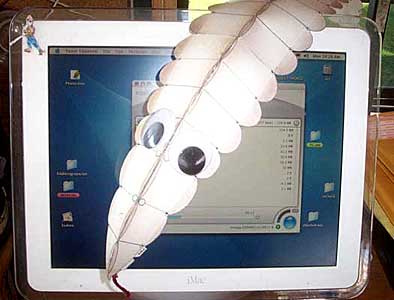
Get a couple big plastic eyes and scare the stuffin's out of the
kids after you build the keel.
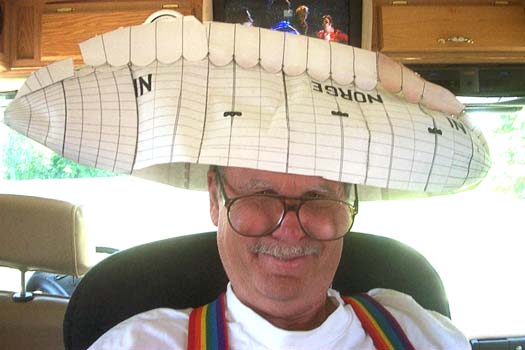
If you give up midway through this project, (like I almost did
MANY times) your Norge model makes into a hat that impresses the
neighbors big time. Helpful also, in getting a seat all to yourself
on a crowded bus or train
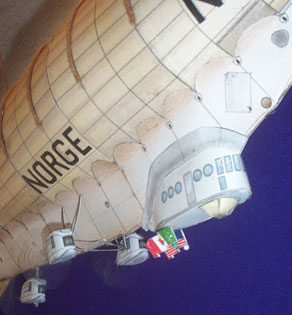
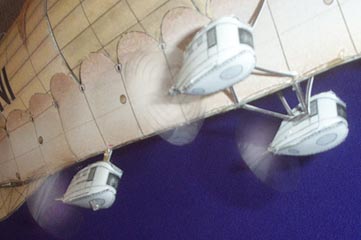
Here are some photos of the Norge Model.. The model was suspended
by chords that were 'airbrushed' out. The plastic prop discs
below were enhanced a little as well.
The Gondola, engine cars, and flags looking up
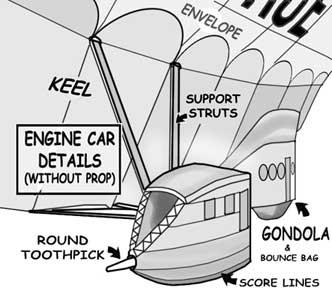
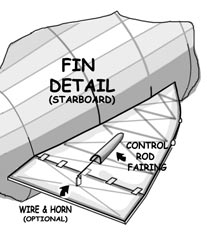
These are a couple sketches taken from the pages of the model
Specifications for the Norge N1 Airship
Lifting gas: hydrogen Length: 348 ft Diameter: 85 ft Gas capacity: 19,000 m³ Performance: 71 mph Payload: 20,944 lbs Engines: 3 Maybach total power of 780 Hp |
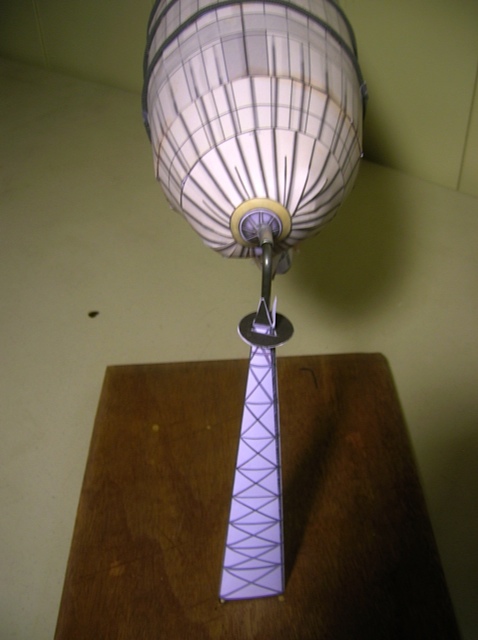 |
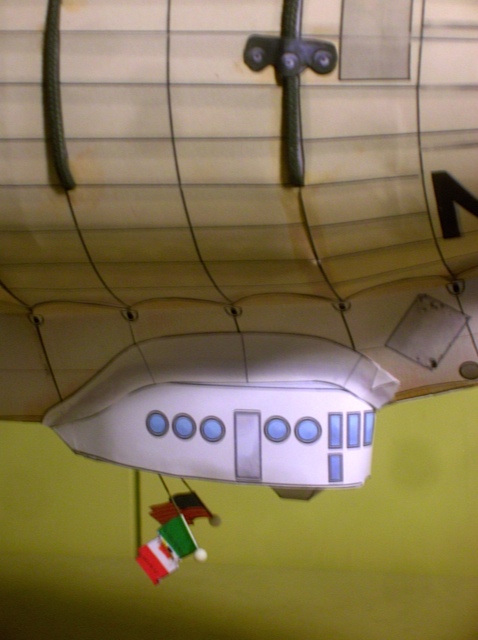 |
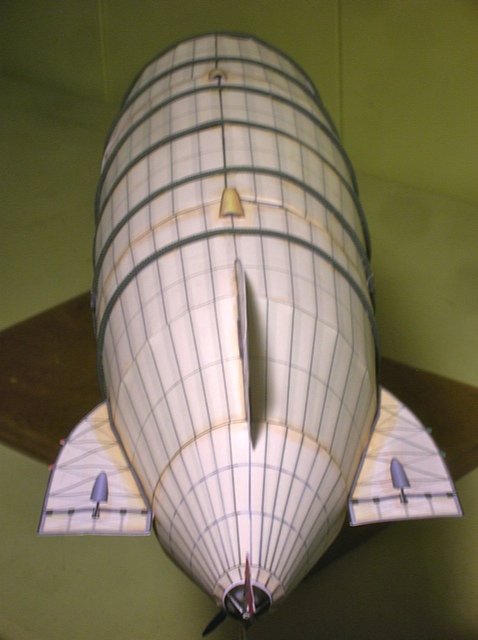 |
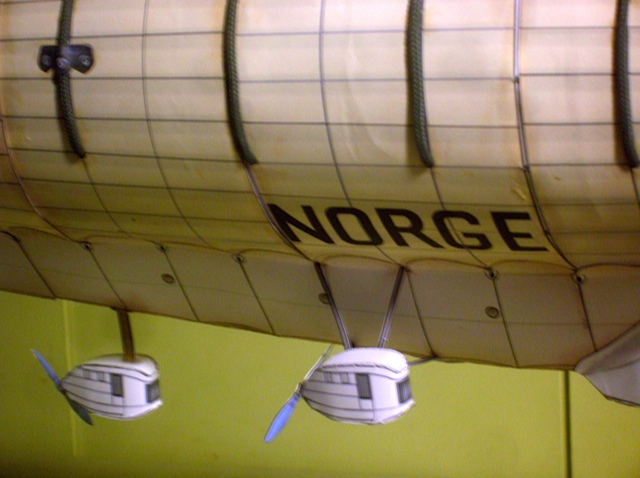 |
Boy, this was a real challenge. A very stiff wire runs all the way to the tail and down through the mast into the wooden base. I strengthened each section of the body with a circle of cardboard to keep them circular and stiffer.
|
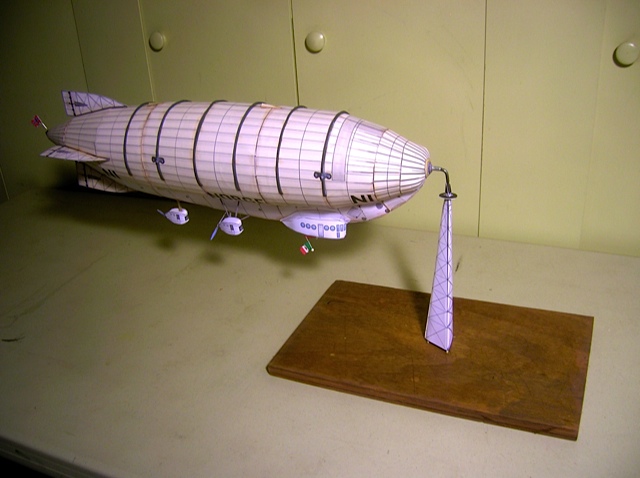
|




